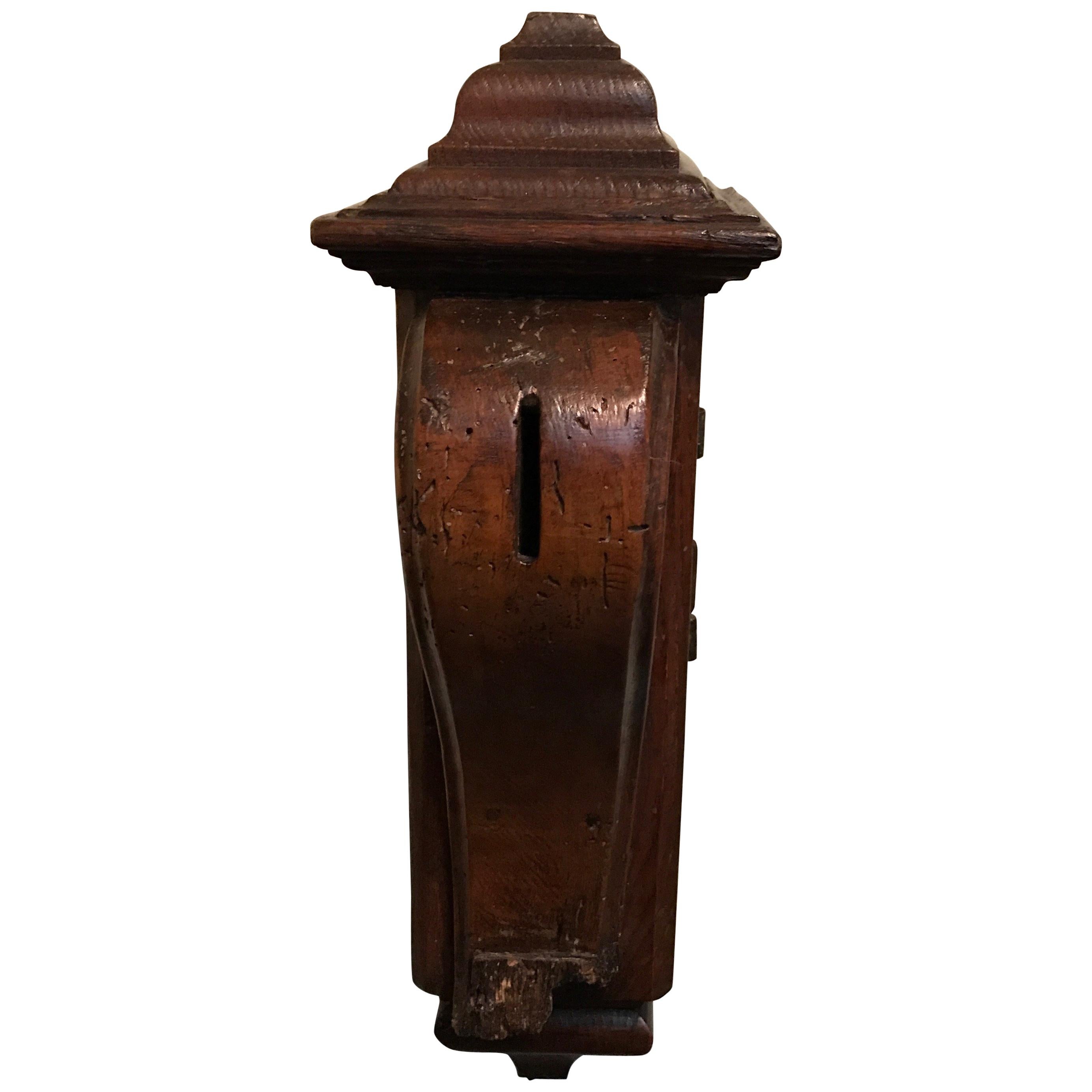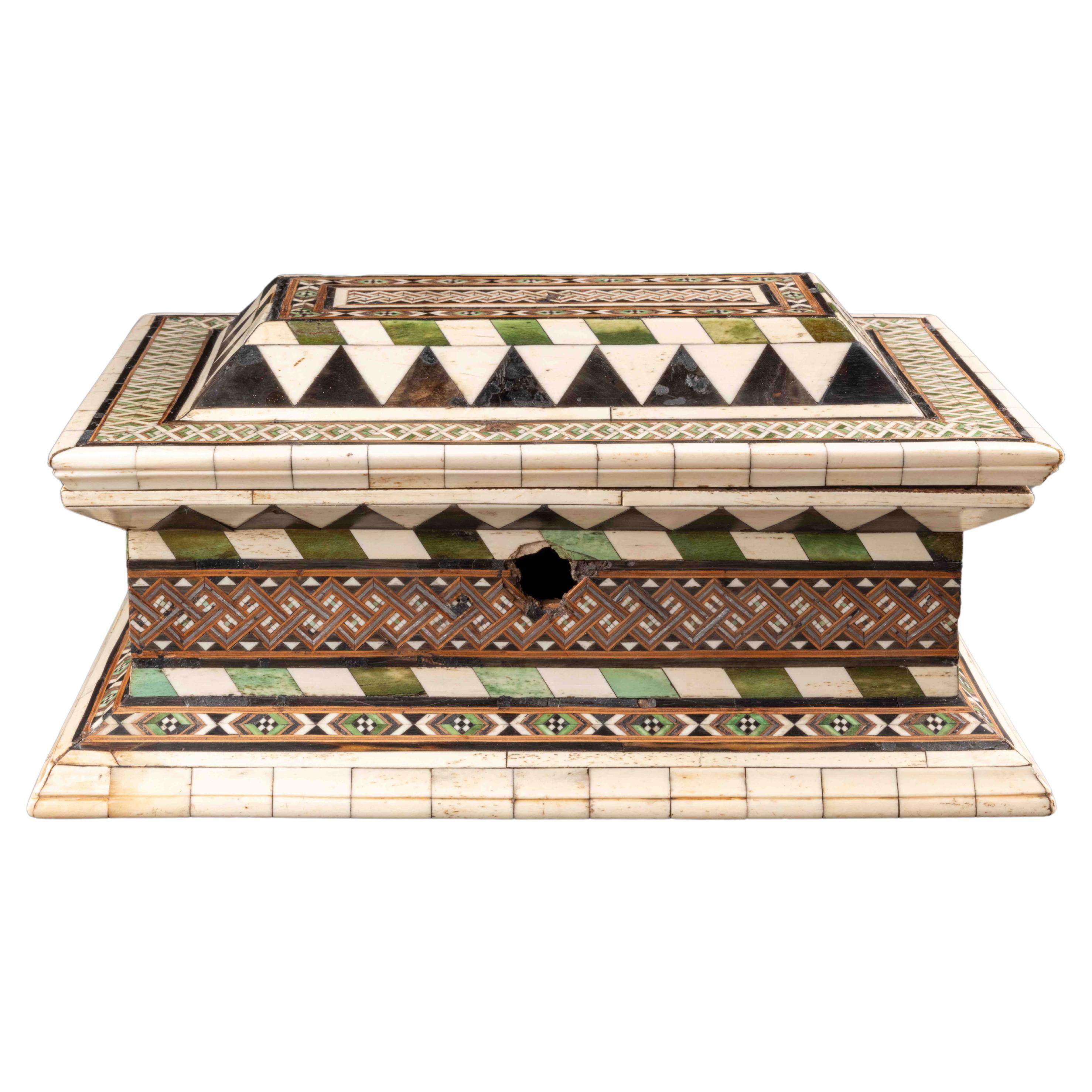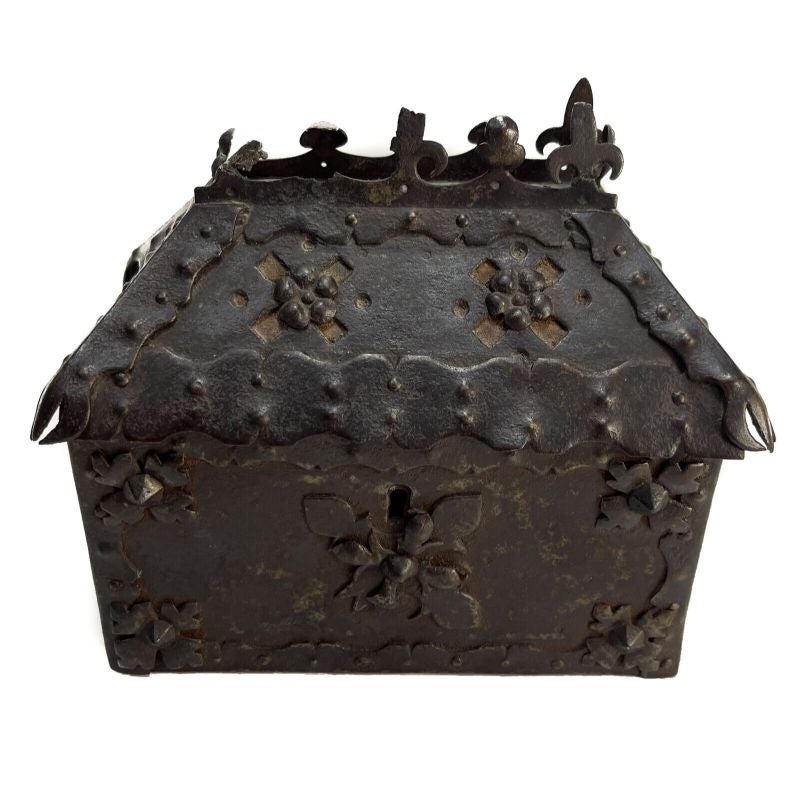Items Similar to Very Rare Casket Minnekästchen or Box, Germany or Italy, 15th Century
Want more images or videos?
Request additional images or videos from the seller
1 of 11
Very Rare Casket Minnekästchen or Box, Germany or Italy, 15th Century
About the Item
Wooden coffret, call minnekästchen, engraved with a dog, a hare and foliage with
polychromy remains. During the Middle Age, the hare is a symbol of fertility, joy and represents the Christ’s resurrection. The top is adorned by a frieze of rhombuses and marked with a slot.
Old collector’s label.
Southern Germany or Northern Italy, 15th century.
- Dimensions:Height: 5.91 in (15 cm)Width: 12.6 in (32 cm)Depth: 5.91 in (15 cm)
- Style:Gothic (Of the Period)
- Materials and Techniques:
- Place of Origin:
- Period:15th Century and Earlier
- Date of Manufacture:1450
- Condition:Wear consistent with age and use.
- Seller Location:Beuzevillette, FR
- Reference Number:1stDibs: LU266337427693
About the Seller
4.9
Platinum Seller
These expertly vetted sellers are 1stDibs' most experienced sellers and are rated highest by our customers.
Established in 2010
1stDibs seller since 2017
243 sales on 1stDibs
Typical response time: 2 hours
- ShippingRetrieving quote...Ships From: Beuzevillette, France
- Return PolicyThis item cannot be returned.
More From This SellerView All
- Jewelry Boxes or Wooden Box with Key, Restauration Period 19th, FranceLocated in Beuzevillette, FRCharming jewelry box or case. The box has a compartment for rings and 3 compartments for earrings, necklaces, bracelets, stones. Very interesting opening mechanism with pusher syst...Category
Antique Mid-19th Century French Restauration Jewelry Boxes
MaterialsWood
- Japan Red Lacquered Box 19th centuryLocated in Beuzevillette, FRBeautiful Japanese box in red lacquered wood. The lid is decorated with golden herons and flowering tree branches and signed by the artist. Black flowers are painted around the box. ...Category
Antique Late 19th Century Decorative Boxes
MaterialsWood
- Early 20th Century Japanese Pillow BoxLocated in Beuzevillette, FRVery nice box also used as a pillow in the Japanese culture, early 20th century. It is black lacquered and decorated with hand painted golden floral patterns. The copper latch is nic...Category
Early 20th Century Japanese Decorative Boxes
MaterialsWood
- Japan Red Lacquered Box 19th CenturyLocated in Beuzevillette, FRBeautiful Japanese box in red lacquered wood. The lid is decorated with flowering magnolia branches and signed by the artist. The inside of the box is covered with a paint loaded wit...Category
Antique Late 19th Century Jewelry Boxes
MaterialsWood
- Japan Red Lacquered Box 19th centuryLocated in Beuzevillette, FRBeautiful Japanese box in red lacquered wood; 19th century The lid is decorated with a landscape with a bird, trees and a setting sun. The inside of the box is covered with a lacque...Category
Late 20th Century Decorative Boxes
MaterialsWood
- 19th Century Box in Lather and SilkLocated in Beuzevillette, FRBeautiful glove box from the end of the 19th century, entirely sheathed in leather with a beveled glass on the cover. The interior is covered with a padded blue silk.Category
Antique 1880s French Decorative Boxes
MaterialsLeather, Silk, Glass
You May Also Like
- 15th Century Offertory Box Very Very RareLocated in Diest, Vlaams BrabantFrom the Elisabeth Gasthouse clinic in Diest Flanders between 1250 and 1450 After that year owners changed More info on the internet Or mail me Very rare peace with big history a...Category
Antique 15th Century and Earlier Belgian Baroque Decorative Boxes
MaterialsWood
- Embriachi workshop marquetry casket - Northern Italy, 15th centuryLocated in Bruxelles, BEEmbriachi workshop marquetry casket Northern Italy, 15th century Alla certosina inlays (bone, stained bone, pewter and wood) H 28.2 x W 18 x D 14 cm This beautiful casket of rectangular form is richly decorated with the characteristic geometric patterns of the Embriachi style. The intricate geometric patterns are fashioned by juxtaposing lighter and darker pieces of wood, (colored) bone, horn and pewter. The lid and base are framed by a broad band of horn. When ivory became scarce in Europe due to disrupted trade routes, bone was substituted. The attention to Symmetry and balance created an harmonious visual effect Enhancing the overall aesthetic appeal of the casket. The application of geometrical motifs is in Italy known as marquetry ‘alla Certosina’, named after the Certosina Church in Pavia with its famous altarpiece decorated in this way. This is ‘intarsia technique’, a term derived from the Arabic 'tarsi', which means ‘incrustation' recalling ancient mosaics made from various materials. These geometric elements not only enhance the aesthetic appeal of the caskets but also demonstrate the versatility and skill of the artisans in creating multifaceted works of art. ‘Alla Certosina’ became famous through the Northern Italian Embriachi family who achieved a particularly high standard in working in this technique. Venice in particular was known for the production of these luxurious boxes. The caskets, hexagonal or rectangular, surmounted by a lid decorated in several registers constitute the secular, albeit equally renowned component of the workshop’s production, in addition to mirror frames and various everyday objects. The method of fabrication of those objects was based on two concepts that underlay pre-industrial production: standardization and modularity, thanks to a distribution of skills according to the different phases of fabrication. even the realization of the marquetry motifs (in the form of ingots from which portions of the desired size were cut) were therefore entrusted to various specialized craftsmen, as were the assembly phase. Today better known thanks to the extensive research work recently carried out by Michele Tomasi, this workshop owes its name to its founder and owner, the Florentine Baldassare Ubriachi (or degli Embriachi), a merchant and banker established in the Tuscan capital before he settled in Venice in 1395. Together with sculptor Giovanni di Jacopo, who directed the workshop, from the last years of the fourteenth century, Baldassare oversaw a production that was truly original, and still easily recognizable today, comprising monumental altarpieces and various objects, primarily triptychs and caskets. The precise location of the workshop is unknown, except that it originated in Florence and in ca. 1431 there was apparently a workshop in Venice, in the area of S Luca. They employed local workers specializing in 'certosina' (inlay of stained woods, bone and horn), and the workshop produced items carved in bone (usually horse or ox) with wood and bone marquetry. The geometric decoration of Embriachi caskets reflects the artistic complexity and attention to detail that characterized their work. this inlaid casket is a testament to the skill and artistry of the Embriachi family and serves as a stunning example of the decorative arts of the late Middle Ages. Related Literature : E. Berger, Prunk-Kassetten: Europäischen Meisterwerke aus acht Jahrhunderten / Ornamental Caskets...Category
Antique 15th Century and Earlier Italian Renaissance Decorative Boxes
MaterialsPewter
- Medieval Patinated Iron-Mounted Oak Casket, 15th CenturyLocated in Gardena, CAMedieval patinated iron-mounted oak casket, 15th century A Continental Medieval patinated iron mounted oak wood box. 15th Century or earlier. Addition...Category
Antique 15th Century and Earlier Medieval Decorative Boxes
MaterialsIron
- Vintage Italian painted ceramic jewel box or casketBy Midcentury Italian schoolLocated in Milano, ITIn the midst of the 1970s, in the heart of the enchanting Italian island of Sicily, artisans crafted a masterpiece of elegance and sophistication—a jewel of a jewelry box, if you wil...Category
Vintage 1970s Italian Mid-Century Modern Decorative Boxes
MaterialsCeramic
- Antique 19th Century Brass Renaissance Revival Casket or Table BoxLocated in Philadelphia, PAA fine antique 19th Century brass casket or table box. In the Renaissance Revival style. With embossed brass sheet side panels, a domed lid, bail handle, and scroll & leaf work fee...Category
Antique 19th Century Renaissance Revival Decorative Boxes
MaterialsBrass
- Very Rare 17th Century Charles II English BoxLocated in Greenwich, CTA very rare and desirable 17th century English oak box having moulded front and sides, original lock plate, drop pulls and bun feet, with superb color and patination. The box is made...Category
Antique 18th Century and Earlier English Boxes
MaterialsOak
Recently Viewed
View AllMore Ways To Browse
Banksy Save Or Delete
Collier Or 200grammes
Antique Or
Very Old Antique Furniture
Middle Age
Middle Ages
15th Wood
15th Italian
15th Century Italy
15th Century Italian
Antique Slots
Old Wooden Box
15th Century Italian Furniture
Italian Gothic Furniture
Italian Gothic
Southern Germany
Christal Objects
German Polychromed





